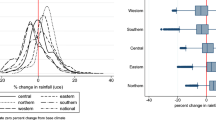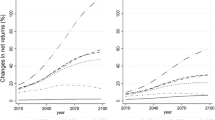Abstract
The economic effects of a doubling of atmospheric carbon dioxide concentration on world agriculture under two alternative crop response scenarios are empirically estimated. These effects include both changes in the prices of agricultural commodities as a result of changes in domestic agricultural yields, and changes in economic welfare following altered world patterns of consumption and production of agricultural commodities. Under both scenarios, with a few exceptions, the effects on national economic welfare are found to be quite modest. However, prices of agricultural commodities are estimated to rise considerably under the more pessimistic scenario. Increased agricultural prices reduce consumer surplus and diminish the benefits from climate change that some countries with predicted positive yield effects would otherwise receive.
Similar content being viewed by others
References
Adams, R., McCarl, B., Dudek, D., and Glyer, J.: 1988, ‘Implications of Global Climate Change for Western Agriculture’, Western J. Agric. Econ. 13 (2), 348–356.
Adams, R., Rosenzweig, C., Peart, R., Ritchie, J., McCarl, R., Glyer, J., Curry, R., Jones, J., Boote, K., and Allen Jr., L.: 1990, ‘Global Climate Change and U.S. Agriculture’, Nature 345 (17), 219–223.
Arthur, L.: 1988, ‘The Greenhouse Effect and the Canadian Prairies’, in Johnston, G., Freshwater, D., and Favero, P., (eds.), Natural Resource and Environmental Policy Issues, Westview Press, Inc., Boulder.
Gadson, K., Price, J., and Salathe, L.: 1982, ‘Food and Agricultural Policy Simulator (FAPSIM): Structural Equations and Variable Definitions’, ERS Staff Report No. AGES820506, U.S. Department of Agriculture, May 1982.
Grotch, S.: 1989, ‘Regional Intercomparison of General Circulation Model Predictions and Historical Climate Data’, U.S. Department of Energy, Office of Energy Research, DOE/NBB/0084, Washington, D.C.
Haley, S. and Dixit, P.: 1988, ‘Economic Welfare Analysis: An Application to the SWOPSIM Modeling Framework’, ERS Staff Report Number AGES871215, U.S. Department of Agriculture, Washington.
Holland, F. and Sharples, J.: 1981, ‘WHEATSIM: Model 15 Description and Computer Program Documentation’, Station bulletin No. 319, Purdue University, March 1981.
Intergovernmental Panel on Climate Change: 1990, Climate Change: The IPCC Scientific Assessment, Cambridge University Press, Cambridge.
Katz, R.: 1979, ‘Climate Model Simulations of the Equilibrium Climatic Response to Increased Carbon Dioxide’, Rev. Geophys. 25, 760–798.
Kokoski, M. and Smith, V.: 1987, ‘A General Equilibrium Analysis of Partial-Equilibrium Welfare Measures. The Case of Climate Change’, Amer. Econ. Rev. 77, 331–341.
Krissoff, B., Sullivan, J., and Wainio, J.: 1990, ‘Developing Countries in an Open Economy: The Case of Agricultural Trade’, in Goldin, I. and Knudsen, O. (eds.), Agricultural Trade Liberalization, Organization for Economic Cooperation and Development, Paris, France.
Liverman, D.: 1987, ‘Forecasting the Impact of Climate on Food Systems: Model Testing and Model Linkage’, Climatic Change 11, 267–285.
Meyers, W, Devadoss, S., and Helmar, M.: 1986, ‘Baseline Projections, Yield Impacts and Trade Liberalization Impacts for Soybeans, Wheat, and Feed Grains: A FAPRI Trade Model Analysis’, Working Paper No. 86-WP2, The Center for Agricultural and Rural Development, University of Iowa.
National Climate Program Office: 1989, ‘Climate Impact Response Functions’, Report of the Coolfront Workshop, West Virginia, September 11–14,1989.
National Research Council: 1987, Current Issues in Atmospheric Change, National Academy Press, Washington.
Organization for Economic Cooperation and Development: 1987, National Policies and Agricultural Trade, Paris, France.
Parikh, K., Fischer, G., Frohberg, K., and Gulbrandsen, O.: 1988, Towards Free Trade in Agriculture, Martinus Nijhoff Publishers, Dordrecht.
Parry, M., Carter, T., and Konijn, N. (eds.): 1988, The Impact of Climatic Variations on Agriculture, Volume 1: Assessments in Cool Temperate and Cold Regions, IIASA/UNEP, and Volume 2: Climatic Change May 1992 Assessments in Semi-Arid Regions, IIASA/UNEP, Kluwer Academic Publishers, Boston.
Parry, M.: 1990, Climate Change and World Agriculture, London, Earthscan Publications Limited.
Peart, R., Jones, J., and Curry, R.: 1990, ‘Impact of Climate Change on Crop Yield in the Southeastern U.S.A.’, in The Potential Effects of Global Climate Change on the United States, Report to Congress, Volume 3, Washington, D.C.
Ray, D. and Richardson, J.: 1978, ‘Detailed Description of POLYSIM’, Technical Bulletin T-151, Agricultural Experiment Station, Oklahoma State University, December 1978.
Ritchie, J., Gaer, B., and Chou, T.: 1990, ‘Effect of Global Climate Change on Agriculture: Great Lakes Region’, in The Potential Effects of Global Climate Change on the United States, Report to Congress, Volume 3, Washington, D.C.
Roningen, V: 1986, ‘A Static World Policy Simulation (SWOPSIM) Modeling Framework’, ERS Staff Report AGE860625, U.S. Department of Agriculture, Washington.
Roningen, V. and Dixit, P.: 1989, ‘How Level is the Playing Field?’, Foreign Agricultural Economic Report Number 239, Economic Research Service, U.S. Department of Agriculture, Washington.
Rosenzweig, C.: 1990, ‘Potential Effects of Climate Change on Agricultural Production in the Great Plains: A Simulation Study’, in The Potential Effects of Global Climate Change on the United States, Report to Congress, Volume 3, Washington, D.C.
Sanier, B.: 1985, ‘The Use of General Circulation Models in Climate Impact Analyses - A Preliminary Study of the Impacts of a CO2 Induced Climate Change on West European Agriculture’, Climatic Change 7, 71–93.
Sonka, S. and Lamb, P.: 1987, ‘On Climate Change and Economic Analysis’, Climatic Change 11, 291–311.
Sullivan, J., Wainio, J., and Roningen, V.: 1989, ‘A Database for Trade Liberalization Studies’, ERS Staff Report Number AGES89–12, U.S. Department of Agriculture, Washington.
USDA: 1989, ‘World Agricultural Trends and Indicators, 1970–88’, ERS Statistical Bulletin Number 781, U.S. Department of Agriculture, Washington.
USEPA: 1990, The Potential Effects of Global Climate Change on the United States, Volume 1–3, Report to Congress, U.S. Environmental Protection Agency, Washington, D.C.
Walker, B., Young, M., Parslow, J., Crocks, K., Fleming, P., Margules, C., and Landsberg, J.: 1989, ‘Global Climate Change and Australia: Effects on Renewable Natural Resources’, CSIRO Division of Wildlife and Ecology, Canberra, Australia.
Webb, A., Lopez, M., and Penn, R.: 1990, ‘Estimates of Producer and Consumer Subsidy Equivalents’, ERS Statistical Bulletin Number 803, U.S. Department of Agriculture, Washington.
Willig, R.: 1976, ‘Consumer Surplus without Apology’, Amer. Econ. Rev. 66, 589–97.
World Bank: 1988, World Development Report 1988, Oxford University Press, New York.
Zhang, J.: 1989, ‘The CO2 Problem in Climate and Dryness in North China’, Meterol. Monthly 15, 3–8.
Author information
Authors and Affiliations
Additional information
Authorship is equally shared. Reilly and Tobey are with the Resources and Technology Division, Economic Research Service, United States Department of Agriculture. Kane is with the National Oceanic and Atmospheric Administration, U.S. Department of Commerce. We are grateful for the research assistance of Rhonda Bucklin, and the thoughtful comments of three anonymous reviewers. The views expressed in this paper are the authors' own and do not necessarily represent the views of the U.S. Department of Agriculture or the U.S. Department of Commerce.
Rights and permissions
About this article
Cite this article
Kane, S., Reilly, J. & Tobey, J. An empirical study of the economic effects of climate change on world agriculture. Climatic Change 21, 17–35 (1992). https://doi.org/10.1007/BF00143251
Received:
Revised:
Issue Date:
DOI: https://doi.org/10.1007/BF00143251




